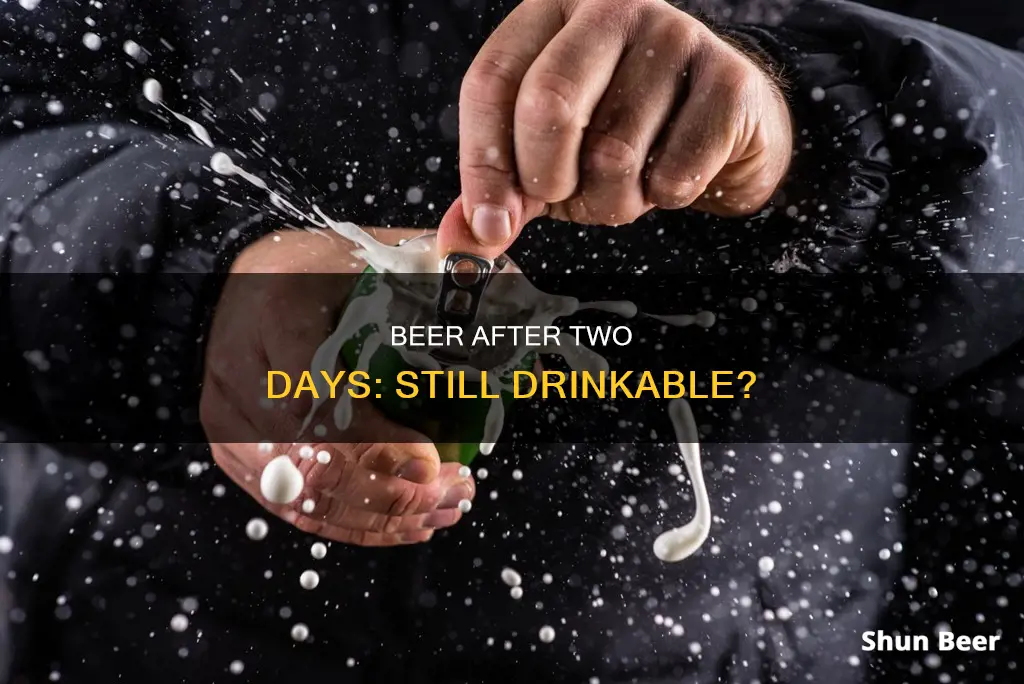
Beer is a beloved beverage for many, but what happens if you don't finish the whole bottle in one sitting? Is it safe to drink after being opened for two days? The short answer is yes, you can still drink beer after it has been opened for two days without risking any health hazards. However, the taste and quality of the beer will definitely take a hit.
Several factors affect how long an open beer can last, including temperature, sunlight exposure, and oxygen exposure. Beer stored in a refrigerator will last longer than beer left out at room temperature, as heat speeds up oxidation, causing the beer to go stale faster. Leaving beer in direct sunlight or exposing it to UV light can also cause skunkiness and a change in flavour due to the sensitivity of hop compounds to light.
Oxygen exposure is another critical factor in beer spoilage. Once a beer bottle is opened, oxidation occurs rapidly, and the beer will lose its carbonation and become flat within 1-2 days. To minimize this, it is recommended to seal the bottle tightly and store the beer upright to reduce the surface area exposed to oxygen.
While drinking a two-day-old open beer may not be pleasant, it is important to note that proper storage can help extend its shelf life. Storing beer in a cool, dark place, such as a refrigerator or cellar, can help maintain its freshness for a few extra days. Additionally, transferring the beer to a smaller bottle or an airtight container can also slow down the oxidation process and preserve its carbonation.
| Characteristics | Values |
|---|---|
| Beer's shelf life | Depends on various factors, including whether it's open or not. |
| Sealed beer shelf life | 4-6 months at room temperature |
| Open beer shelf life | 1-2 days |
| Beer storage temperature | 35°F to 46°F |
| Beer storage place | Cool, dry place, away from direct sunlight and heat |
| Beer storage position | Upright to reduce oxygen exposure |
| Beer spoilage indicators | Unpleasant flavour, musty smell, visible mould, strange taste, cloudy appearance |
| Beer consumption after opening | Safe but with a change in taste |
What You'll Learn
- Beer can be safely consumed after its best before date, but the taste may be affected
- Oxygen, heat, and light are the main causes of beer spoilage
- Beer can be salvaged after opening by using airtight containers and refrigeration
- Improper storage, such as exposure to sunlight, can accelerate beer spoilage
- Beer is best stored upright to minimise oxygen exposure and in a cool, dark place

Beer can be safely consumed after its best before date, but the taste may be affected
Beer is a delicate beverage, and its flavour can be affected by various factors, including oxygen, heat, and light. While it may be safe to consume an open beer after two days, it is essential to understand the impact of time and storage conditions on its quality.
Firstly, let's talk about the role of oxygen. When a beer bottle is opened, the beverage is exposed to oxygen, which can lead to oxidation. This process causes an undesirable papery or cardboard-like taste in the beer. The longer the beer is left open, the more pronounced the oxidation will be. To minimise oxidation, it is recommended to seal the bottle tightly or transfer the beer to an airtight container.
Heat is another crucial factor. Storing beer at room temperature or exposing it to temperature fluctuations can accelerate the deterioration process. Heat speeds up oxidation, causing the beer to lose its freshness and flavour. To maintain the quality of the beer, it should be stored in a refrigerator or a cool, dark place.
Light, especially UV light, can also negatively impact beer. Beer bottles are often dark or made of aluminium cans to block UV rays. However, once a beer is opened, light exposure becomes a concern. Prolonged exposure to light can trigger a chemical reaction, breaking down the taste components and causing flavour deterioration. Therefore, it is advisable to keep opened beer away from direct sunlight or strong artificial light.
While it is safe to consume beer after its "best before" date, the taste may be affected. The fermentation process, low pH level, and alcohol content make beer resistant to bacterial growth, even if it sits on the shelf for years. However, the flavour can change over time, and the beer may lose its carbonation, resulting in a flat and unpleasant taste.
To extend the shelf life of an opened beer, it is recommended to store it in a cool, dark place, minimise exposure to oxygen by sealing the bottle tightly, and consume it within a few days. Additionally, transferring the beer to a smaller container can help reduce the air gap, slowing the loss of carbonation.
Chickens and Beer: A Safe Combo?
You may want to see also

Oxygen, heat, and light are the main causes of beer spoilage
Oxygen
Oxygen exposure is a significant factor affecting beer's shelf life and quality. When oxygen comes into contact with beer, it causes oxidation, degrading the beverage's flavour and changing its colour. Beer in bottles is more susceptible to oxygen exposure than beer in cans. To minimise this risk, store the beer upright to reduce the surface area in contact with oxygen.
Heat
Temperature plays a pivotal role in determining a beer's shelf life. If you store beer in a warm place above room temperature, its freshness will decrease quickly. On the other hand, storing it in a refrigerator prolongs its freshness. Ideally, you should store beer at typical refrigerator conditions—35°F to 46°F.
Light
The sun's rays are notorious for shortening beer's shelf life. They penetrate bottles and trigger a chemical reaction that breaks down its taste components, causing flavour deterioration. UV exposure affects bottled beer and craft varieties such as IPAs, Pale Ales, Kolsch, and Amber if not stored properly in dark places.
Beer and Pancreatitis: What You Need to Know
You may want to see also

Beer can be salvaged after opening by using airtight containers and refrigeration
Beer is a delicate beverage, and its flavour can be significantly impacted by exposure to oxygen, heat, and light. Once a bottle or can of beer is opened, oxidation occurs, and if the beer is left out, it will soon turn stale and flat. However, there are ways to salvage opened beer and prolong its freshness.
The key to preserving beer is to minimise its exposure to oxygen, maintain cool temperatures, and prevent UV light from reaching the beverage. Here are some effective methods to achieve this:
Use Airtight Containers
Airtight containers are essential to prevent oxygen from reaching the beer and causing oxidation, which leads to a loss of flavour and quality. Beverage canisters or recycled plastic soda bottles can be used to store the beer, protecting it from oxygen, light, and bacteria.
Refrigeration
Storing beer at cool temperatures is crucial to slow down the oxidation process and extend its shelf life. Keeping the beer in a refrigerator will help maintain its freshness and flavour. The ideal temperature range for storing beer is between 35°F and 46°F (2°C to 8°C).
Add Sterile Beer Salts
Adding a few drops of sterile beer salts to the beer can create an environment that inhibits the growth of germs. This is especially beneficial for stronger alcoholic brews, which are more prone to oxidation than lighter beers.
Monitor for Spoilage
Even with proper storage, beer can eventually spoil. It is important to check for indicators of spoilage, such as an unpleasant flavour, a musty smell, or visible mould. If any of these signs are present, the beer should be discarded.
Store Upright
Storing beer bottles or cans upright helps minimise the surface area exposed to oxygen, preserving the beer's freshness.
By following these methods, you can effectively salvage and prolong the freshness of opened beer. However, it is important to note that even with proper storage, the flavour and quality of beer will gradually deteriorate over time. Therefore, it is best to consume the beer as soon as possible after opening to enjoy it at its optimal condition.
Beer in Winter: A Cozy Conundrum
You may want to see also

Improper storage, such as exposure to sunlight, can accelerate beer spoilage
Exposure to sunlight and improper storage conditions can significantly impact the quality and taste of beer. Beer is best stored in a cool, dark place, like a refrigerator or cellar, and in an airtight container. This is because the UV rays in sunlight are the drink's "archenemy", triggering a chemical reaction that breaks down its taste components and causes flavour deterioration.
The sun's rays penetrate beer bottles, causing a chemical reaction that breaks down the flavour compounds in the beer. This process is particularly prominent in beers like India Pale Ales and other light beers, which are best consumed within three months of packaging. Even after being refrigerated, a beer that has been left out in the sun for a day will likely be flat and have an unpleasant flavour.
Dark beers absorb a broader spectrum of light wavelengths than lighter beers, so the propensity for skunkiness increases as the beer colour lightens. The same is true of glass bottles; brown glass absorbs the blue, purple, and green wavelengths that catalyse the skunk reaction, whereas clear, green, and blue glass allow some or all of these wavelengths to pass through into the beer.
In addition to sunlight, beer is susceptible to oxygen exposure, which can cause oxidation and change its colour. Bottled beer is more vulnerable to this than canned beer, so it's recommended to store beer upright to reduce the surface area in contact with oxygen.
To summarise, improper storage conditions, such as exposure to sunlight, can accelerate beer spoilage. Sunlight triggers chemical reactions that break down flavour compounds, and this process is exacerbated in lighter-coloured beers and those packaged in clear, green, or blue glass bottles. Oxygen exposure also contributes to spoilage, so storing beer upright can help minimise this risk.
Beer and Breastfeeding: What's Safe?
You may want to see also

Beer is best stored upright to minimise oxygen exposure and in a cool, dark place
Storing beer upright is an effective way to reduce oxygen exposure, which can cause oxidation and significantly alter the taste of the beer. Upright storage also helps to prevent the formation of a yeast ring or watermark inside the bottle from dead yeast cells. By storing beer upright, the yeast will settle at the bottom of the bottle, minimising its influence on the flavour.
Additionally, storing beer in a cool, dark place is crucial to maintaining its freshness and quality. Beer is susceptible to sunlight and UV ray exposure, which can trigger a chemical reaction that breaks down its taste components. Cool temperatures also help to slow down the oxidation process and extend the shelf life of the beer. Therefore, it is recommended to store beer in a refrigerator or a cool, dark place like a pantry or cellar to maintain optimal freshness and flavour.
By following these storage guidelines, beer enthusiasts can ensure that their beer remains in the best possible condition and minimise the risk of spoilage.
Beer and Fitness: Can You Drink and Still Get Ripped?
You may want to see also
Frequently asked questions
Yes, you can drink beer that has been left open for 2 days. However, it is recommended to consume the beer within 24-48 hours of opening it to relish its optimal taste and quality. After this time frame, the beverage will likely lose its carbonation, flavour, and freshness.
The shelf life of beer depends on various factors, including temperature, sunlight exposure, and oxygen exposure. Beer should be stored in a cool, dry, and dark place, preferably in a refrigerator, to prolong its freshness.
Drinking beer that has been left open for more than 2 days is generally safe, but the taste and quality will deteriorate. The beer may become flat, develop an unpleasant flavour, and lose its carbonation.
To extend the shelf life of opened beer, seal the bottle or can tightly to prevent oxygen exposure. Store the beer in a cool, dark place, and consume it as soon as possible. Using airtight containers or adding sterile beer salts can also help preserve the beer for a few extra days.







